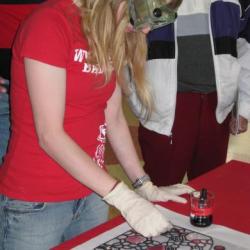Source Institutions
Source Institutions
Add to list Go to activity
Activity link broken? See if it's at the internet archive

In this activity/demo, learners are introduced to the connection between medieval stained glass artisans and nanotechnology. Learners discover that the red and yellow colors in stained glass windows come from nanoparticles of gold and silver embedded in the glass. This activity/demo consists of two hands-on activities: making a collaborative stained glass window with pre-made nanoparticle solutions containing silver or gold and making a take-away card that contains a small piece of nanoparticle stained “glass."
- 4 to 24 hours
- 10 to 30 minutes
- Over $20 per group of students
- Ages 6 - adult
- Activity, Demonstration, Experiment/Lab Activity, Lesson/Lesson Plan
- English
Quick Guide
Materials List (per group of students)
- Circular craft punch to make “windows” in cards
- Lamination sheets cut in 1.5” x 1.5” squares (2 squares for each take home card)
- Scissors
- Containers to organize components (suggested)
- Colored pencils/crayons (optional)
- Plexiglass panel (suggested 18”x24”) (available at local hardware stores)
- Simulated liquid leading (DecoArt Liquid Leading Paint, available at arts and craft stores or on-line; small bottle approximately $2.00)
- 2 labeled plastic cups/containers to hold the solutions (best not to use drinking cups, since it makes the solutions look ingestible)
- Latex and Nitrile gloves (variety of sizes, available from Fisher Scientific)
- Safety glasses (available at local hardware stores or Fisher Scientific)
- Paper towels
- White poster board or foam core to go under plexiglass panel to make panel more visible (available at local arts and crafts stores)
- Silicone baking molds (cupcake/muffin cups work well, available at home good stores, e.g. Target or Bed, Bath and Beyond)
- Toaster oven (optional, but recommended, available at home good stores, e.g. Target or Bed, Bath and Beyond)
- Magnetic stir bar
- Hot/stir plate (or a separate hot plate and stir plate)
- Ice
- Large container to use as ice bath
- Graduated cylinders for measuring solution volumes
- 50ml Erlenmeyer flask or beaker
- Droppers/pipettes
- 0.0189 g NaBH4 (sodium borohydride) (available from Aldrich)
- 0.017g AgNO3 (silver nitrate) (available from Aldrich)
- 0.1 g polyvinyl pyrrolidone (PVP) (available from Aldrich)
- 40 g polyvinyl alcohol (PVA) (available from Aldrich)
- 1 liter distilled water
- 0.1g HAuCl4·3H2O (hydrogen tetrachloroaurate) (available through Aldrich)
- 0.5 g Na3C6H5O7·2H2O (sodium citrate) (available through Aldrich)
- 2 liters distilled water.
- (Optional) Examples of traditional stained glass
- (Optional) Pictures of a variety of traditional stained glass (windows, Tiffany-style lamps, etc.)
- Nanoparticle Stained Glass program card (front)
- Nanoparticle Stained Glass program card (back)
Subjects
-
Engineering and Technology
-
Engineering
- Metallurgy and Materials Engineering
- Nanotechnology
-
Engineering
-
Physical Sciences
- Vibration and Waves
-
Light and Optics
- Electromagnetic Spectrum
- Sunlight and Color
Informal Categories
- Arts and Crafts
Audience
To use this activity, learners need to:
- see
- see color
- touch
Learning styles supported:
- Links STEM to other topics of interest such as arts and humanities
- Involves hands-on or lab activities
Other
Components that are part of this resource:
- Nanoparticle Stained Glass Cart program Lesson Plan
- Nanoparticle Stained Glass Presentation Slides
- Nanoparticle Stained Glass Presentation
- Demo Training Video (Glass Activity)
- Demo Training Video (Card Activity)
- Nanoparticle Stained Glass Cart Training Video
This resource is part of:
Access Rights:
- Free access
By:
Rights:
- Creative Commons: Non-commercial Share Alike (by-nc-sa), Nanoscale Informal Science Education Network,
Funding Sources:
- National Science Foundation, 0532536
- National Science Foundation, 0940143
